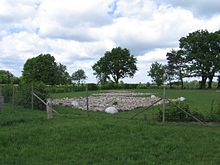Heinrich von Borch
Heinrich von Borch or Henry IV of Borch. (* 1290, † unknown), also called " Isern Hinnerk " ( Low German for, Iron Heinrich '), was in the 14th century stiftsbremischer Knappe from Horneburg , later known as robber barons known has been.
Life

Heinrich von Borch was around 1290, the son of Bremen Ministerialengeschlechts of Borch was born. The von Borch family provided castle men on the Horneburg since 1255. In this capacity, the von Borch were also the judges of the court on the Delm in Apensen .
From 1307 to 1310 the Archdiocese of Bremen was without a bishop. During this time Heinrich von Borch held the castle Vörde and the Vogtei Vörde. It is unclear whether he was given this office or whether he took advantage of the power vacuum and occupied the castle without authorization. In any case, he must have used the office as bailiff in his favor, be it through raids and raids, as the archdiocese said it was, or through a tough regime, as suggested by his nickname "Isern Hinnerk". During this time he began to build his own refuge, the castle in Dannsee near Beckdorf . When the archbishopric got a new bishop in 1310, Johann Grand , he tried to regain the possessions that had been lost, including Vörde Castle. Heinrich von Borch refused to vacate the castle. After various nobles from Northern Germany and Bremen united against Heinrich von Borch, he then voluntarily vacated Vörde Castle and retired to his castle in the Dannsee.
From there he expanded his raids, probably to finance the completion of the not yet fully completed castle. The acts committed in the process caused Johann Grand to excommunicate Heinrich von Borch, but this did not bother him. Only when his raids extended to the Duchy of Lüneburg and the Diocese of Verden did Duke Otto von Lüneburg , the Bishop of Verden and the Archbishop of Bremen come together to put an end to his doings.
The allies attacked Heinrich von Borch at his castle in the Dannsee, which was then completely destroyed in the course of the fighting. However, he was able to flee to his family on the Horneburg , which was then also besieged. He managed to escape his pursuers from there too, but after a long escape he was caught and imprisoned in Vörde. A year later, an attempt by his friends from the Horneburg castle team to free him failed.
In the meantime, Johann Grand fell out with his cathedral chapter and the nobles of the area until open resistance arose. An opposition formed and drew up a list of demands. This also included the rehabilitation of Heinrich von Borch. In 1316 Johann Grand left Bremen, whereupon Heinrich von Borch was released after five years of imprisonment and took over, probably as compensation for his imprisonment, office and castle Ottersberg .
Heinrich von Borch can be documented until 1347, after which his trace is lost.
Isern Hinnerk as a legendary figure
There are various legends and stories about Isern Hinnerk . It is said that, in order to distract his pursuers, he let his horse's horseshoes hit the wrong way round. When he could no longer hold his castle in Dannsee, he is said to have sunk his treasures in a golden cradle in the moor. This should in every 100 years Johannisnacht come back to the surface. Whoever wants it should only approach it backwards and not speak a word. According to another legend, Isern Hinnerk was betrayed by Kiebitzen while he was fleeing from the men of the Archdiocese of Bremen , who felt disturbed by him while he was hiding behind stacked peat.
literature
- Karl Ernst Hermann Krause : Borch, Hinrich v. In: Allgemeine Deutsche Biographie (ADB). Volume 3, Duncker & Humblot, Leipzig 1876, p. 153.
- Klaus Bredehöft: Islands in the moor. From the story of Revenahe-Kammerbusch . Kammerbusch 1984.
- Hans G. Trüper : Knights and Squires between Weser and Elbe. The ministry of the Archbishopric of Bremen. Stade 2000, ISBN 3-931879-05-4 , pp. 326–328.
- Dietrich Alsdorf: Isern Hinnerk - on the trail of a myth in: Archeology in Lower Saxony , 2003, pp. 69–71
- Dietrich Alsdorf: "Dannsee" - the castle of "Isern Hinnerk" . In: Past and Present 2004 . Edited by Association for Monastery and Local History Harsefeld e. V., Harsefeld 2004, pp. 24-44.
Fiction
- Friedrich Köster : Heinrich the Iron, or the knight's castle in the Tannensee . In: Antiquities, stories and legends of the duchies of Bremen and Verden , Stade 1856. ( full text at Wikisource )
- Johann Georg Theodor Grasse : Heinrich the Iron or the Knight's Castle in Tannensee. In: Sagenbuch des Prussischen Staats , Volume 2, Glogau 1868/71. ( Full text at Zeno.org )
- Hans Schablowski: Hinnerk von Borg: a piece from the life of "Isern Hinnerk", Burgmann of Horneburg . Stade 1928.
- Dietrich Alsdorf: Isern Hinnerk. Novel of a medieval legend . Verlag Atelier im Bauernhaus, Fischerhude 2010, ISBN 978-3-88132-321-5 . With historical appendix.
Web links
- Dietrich Alsdorf: The "Isern Hinnerk". Approaching a legendary figure
- Reinhard Dzingel: De ganß grode Schangs - oer de Schatt vun'n Isern Hinnerk , Low German essay on the saga, Moisburg, 2011 (PDF; 938 kB)
| personal data | |
|---|---|
| SURNAME | Borch, Heinrich von |
| ALTERNATIVE NAMES | Borch, Heinrich IV. Von; Isern Hinnerk |
| BRIEF DESCRIPTION | German robber barons |
| DATE OF BIRTH | around 1290 |
| DATE OF DEATH | after 1347 |

